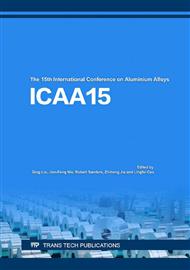[1]
G. Ghosh, G.B. Olson, Computational thermodynamics and the kinetics of martensitic transformation, J. Phase Equilib. 199(2001)83-89.
Google Scholar
[2]
E. Taban, J.E. Gould, J.C. Lippold, Dissimilar friction welding of 6061-T6 aluminum and AISI 1018 steel: Properties and microstructural characterization, Mater. Des. 5(2009)2305-2310.
DOI: 10.1016/j.matdes.2009.12.010
Google Scholar
[3]
S.B. Lin, J.L. Song, G. C Ma, C.L. Yang, Dissimilar metals TIG welding-brazing of aluminum alloy to galvanized steel, Front Sci. Ser. 15 (2009)278-283.
DOI: 10.1007/s11706-009-0007-2
Google Scholar
[4]
D. John, W.D. Kerler, Thermodynamic Properties and Mixing Thermodynamic Parameter of Binary Metallic Melt Involving Compound Formation,J. Iron Steel Rse. 2(2005) 134-139.
Google Scholar
[5]
L. Ming, D. Yang, Electronic structures of Heusler alloy Co2FeAl1-xSix surface, Rare Metal. 2(2012)57-63.
Google Scholar
[6]
D. Keit, W. Yal, Electronic bonding and property of FeAl, Trans. Nonfer. Metals Soci. Chin. 03(2000) 133-138.
Google Scholar
[7]
H.X. Song, Y.X. Wu, C.A. Tang, Microstructure and Mechanical Properties of FeAl Intermetallics Prepared by Mechanical Alloying and Hot-Pressing, Tsi. Sci. Tech. 03(2009)372-377.
DOI: 10.1016/s1007-0214(09)70044-6
Google Scholar
[8]
M.H. Enayati, M. Salehi, Formation mechanism of Fe3Al and FeAl intermetallic compounds during mechanical alloying, J. Mater. Sci. 15( 2005) 3933-3938.
DOI: 10.1007/s10853-005-0718-4
Google Scholar
[9]
L. Agudo, D. Eyidi, H Christian, Intermetallic FexAly-phases in a steel/Al-alloy fusion weld, J. Mater. Sci. 12 (2007) 4205-4214.
DOI: 10.1007/s10853-006-0644-0
Google Scholar
[10]
P. Peyre, G. Sierra, D. Stuart, G. Fras, Generation of aluminium–steel joints with laser-induced reactive wetting, Mater. Sci. Eng. A. 1 (2006) 327-338.
DOI: 10.1016/j.msea.2006.09.111
Google Scholar
[11]
A. Bouayad, C. Gerometta, A. Belkebir, A. Ambari, Kinetic interactions between solid iron and molten aluminium, Mater. Sci. Eng. A . 1(2003) 53-61.
DOI: 10.1016/s0921-5093(03)00469-6
Google Scholar
[12]
K. Bouché, F. Barbier, A. Coulet. Intermetallic compound layer growth between solid iron and molten aluminium, Mater. Sci. Eng. A. 1 (1998)167-175.
DOI: 10.1016/s0921-5093(98)00573-5
Google Scholar
[13]
G. Sierra, P. Peyre, F. Deschaux Beaume, D. Stuart, G. Fras, Galvanised steel to aluminium joining by laser and GTAW processes, Mater. Cha. 12 ( 2008) 1705-1715.
DOI: 10.1016/j.matchar.2008.03.016
Google Scholar
[14]
H.D. Manesh, A.K. Taheri, Bond strength and formability of an aluminum-clad steel sheet, J. Alloys Comp. 1(2003) 138-143.
DOI: 10.1016/s0925-8388(03)00392-x
Google Scholar
[15]
B. Rattana, T.Y. Chi, Y. Miyashita, Y. Mutoh, Suppression of intermetallic reaction layer formation by controlling heat flow in dissimilar joining of steel and aluminum alloy, Mater. Sci. Eng. A. 1(2007) 108-113.
DOI: 10.1016/j.msea.2007.03.049
Google Scholar
[16]
W. J. Cheng, C. J. Wang, Study of microstructure and phase evolution of hot-dipped aluminide mild steel during high-temperature diffusion using electron backscatter diffraction, Appl. Surf. Sci. 10(2010) 4663-4668.
DOI: 10.1016/j.apsusc.2010.12.118
Google Scholar
[17]
M.H. Shojaeifard, R. Talebitooti, B. Ranjbar, Power transmission through double-walled laminated composite panels considering porous layer-air gap insulation, Appl. Math. Mech. 11 (2014) 4668-4673.
DOI: 10.1007/s10483-014-1877-7
Google Scholar


